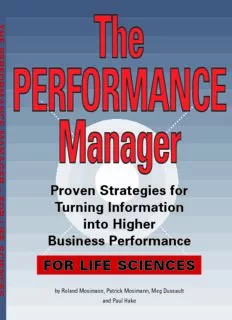
The PERFORMANCE Manager PDF
Preview The PERFORMANCE Manager
TThhee T H E P E R PPEERRFFOORRMMAANNCCEE F O R M A N C MMaannaaggeerr E M A N A G E R Proven Strategies for – F Turning Information O R into Higher L I F E Business Performance S C I FOR LIFE SCIENCES E N C E byRolandMosimann,PatrickMosimann,MegDussault S andPaulHake The PERFORMANCE Manager Proven Strategies for Turning Information into Higher Business Performance FOR LIFE SCIENCES Edited by John Blackmore and Catherine Marenghi Production and Launch Team: Steve Hebbs Kathryn Hughes Randi Stocker ©CopyrightIBMCorporation2009 IBMCanada3755RiversideDriveOttawa,ON,CanadaK1G4K9 ProducedinCanada July2009 AllRightsReserved. IBM,theIBMlogoandibm.comaretrademarksorregisteredtrademarksofInternationalBusinessMachinesCorporationintheUnitedStates, othercountries,orboth.IftheseandotherIBMtrademarkedtermsaremarkedontheirfirstoccurrenceinthisinformationwithatrademarksymbol(®or™), thesesymbolsindicateU.S.registeredorcommonlawtrademarksownedbyIBMatthetimethisinformationwaspublished. Suchtrademarksmayalsoberegisteredorcommonlawtrademarksinothercountries.AcurrentlistofIBMtrademarksisavailableontheWeb at“Copyrightandtrademarkinformation”atwww.ibm.com/legal/copytrade.shtml. ReferencesinthispublicationtoIBMproductsorservicesdonotimplythatIBMintendstomakethemavailableinallcountriesinwhich IBMoperates. Anyreferenceinthisinformationtonon-IBMWebsitesareprovidedforconvenienceonlyanddonotinanymannerserveasanendorsementofthoseWebsites. ThematerialsatthoseWebsitesarenotpartofthematerialsforthisIBMproductanduseofthoseWebsitesisatyourownrisk. TheDecisionSpeed®Framework,theDecisionAreasanditscorecontent,andallintellectualpropertyrightstherein,areproprietaryto BIInternational,andareprotectedbycopyrightandotherintellectualpropertylaws.NopartoftheDecisionSpeed®Framework, theDecisionAreasanditscorecontentcanbereproduced,transferred,distributed,repackaged,orusedinanywaywithout BIInternational'swrittenpermission.DecisionSpeed®andDecisionAreasaretrademarksofBIInternational. TABLE OF CONTENTS Introduction......................................................................................................................................5 Promise:EnablingDecisionAreasthatDrivePerformance...............................................................9 Finance:TrustedAdvisororComplianceEnforcer?........................................................................17 Marketing:InvestmentAdvisortotheBusiness..............................................................................29 Sales:YourBusinessAccelerator.....................................................................................................41 CustomerService:TheRisk/RewardBarometeroftheCompany’sValueProposition....................53 ProductResearch&Development: DevelopingtheRightProduct,theRightWay,attheRightTime...................................................65 Regulatory&LegalAffairs:TheGateOpenerfortheBusiness......................................................77 Manufacturing:WinningattheMargins........................................................................................85 HumanResources:ManagementorAdministrationofHumanCapital?.........................................97 InformationTechnology:APathfindertoBetterPerformance......................................................107 ExecutiveManagement:ChiefBalancingOfficers.........................................................................125 Summary.......................................................................................................................................151 AbouttheAuthors.........................................................................................................................153 3 INTRODUCTION ThePerformanceManagercontinuesanexplorationthatbeganmorethantenyearsagowiththe publicationofTheMultidimensionalManager.Bothbooksexaminethepartnershipbetween decision-makersincompaniesworldwideandthepeoplewhoprovidethemwithbetterinformation todrivebetterdecisions. Morethanadecadeago,thefocuswasonunderstandinganexcitingnewtransformationaltrend— companieswerebecomingmorecustomer-andprofit-centric.Whatdrovethattrend?Companies wererelyingmoreandmoreoninformationassetssuchasbusinessintelligence. Today,thatfocushasbecomeevensharperandmoreimportant.Globalcompetitionand interconnectedglobalsupplychainshavefurtherintensifieddownwardpressuresoncost. TechnologyandtheInternethavetransformedtheknowledgeeconomyfromtheequivalentofa specialtystoreintoa24/7/365big-boxretailer.Vastamountsofcontentareaccessibleanytime, anywhere. Today,companiesareexpectedtohaveadepthofinsightintotheircustomers’needsunheardoften yearsago.Andyetmarketuncertaintyisgreaterthanever.Thepaceofrapidchangedoesnotallow formanysecondchances.Inotherwords,ifbeingcustomer-andprofit-centricwasimportantthen, itiscriticalnow. Tobettersupportthedecision-maker/technologyprofessionalpartnership,TheMultidimensional Managerintroduced24Ways,asetofbusinessintelligencesolutionsusedbyinnovativecompanies todrivegreaterprofitability.Thesesolutionswereorganizedbybusinessfunctionandreflectedthe insightthatthemostvaluableinformationincorporatedecision-makingisconcentratedina relativelysmallnumberofinformation“sweetspots,”nodesinacorporation’sinformationflow. Thebookalsointroducedtwofurtherinsights.First,theemergenceofanewbreedofmanager—the multidimensionalmanager,whocouldeffectivelynavigateandprocesstheseinformationsweetspots andthusmakebetter,fasterdecisions.Second,thematurityoftheenablingtechnology—business intelligence. Thebooklaunchedafascinatingdialogue.Demandledtotheprintingofmorethan400,000copies. Peopleusedittohelpunderstandandcommunicatethepromiseofbusinessintelligence.Thepages oftendog-earedandannotated,itbecameafieldmanualforbusinessandITteamstaskedwith developingsolutionsfortheircompanies.Cognos®(whichcommissionedthebookandisnowpart 5 INTRODUCTION ofIBM),BIInternational(whichco-authoreditanddevelopedthe24Ways)andthecompanyPMSI (whichpartneredcloselywithboth)maintainedadialoguewithhundredsofcompaniesoverthe years,collectingandsynthesizingthemanycommonexperiencesandrefiningthemintoabodyof bestpracticesandsolutionmaps. Tenyearson,ThePerformanceManagerrevisitsthisdialogueandtheunderlyingassumptionsand observationsmadeinthefirstbook.Weshareourconclusionsaboutwhathaschangedandwhat hasbeenlearnedbysuccessfulcompaniesandmanagersintheirattemptstodriveprofitabilitywith betterinformation.Whilethecoreprinciplesoriginallypresentedhaveevolved,theyarestilllargely true.Afterall,businessesexisttoservecustomers,andnotwithstandingthetechboom’sfocuson marketshare,profitistheultimatemeasureofsuccess.ThePerformanceManagerisnotasequel; thoughrelated,itstandsonitsown.Wehopeitwilllaunchanewdialogueamongthoseambitious andforward-lookingmanagerswhoviewinformationnotasacrutchbutasawaytobothdrill downintodetailandsearchoutwardintoopportunity. TheChangingValueofInformation McKinseyQuarterlyresearchsince19971hasfollowedaninterestingtrendthatrelatesdirectlytothe dialoguewestartedadecadeago.Basedonthisresearch,McKinseydistinguishesbetweenthree primaryformsofworkandbusinessactivity: 1.Transformationalwork–Extractingrawmaterialsand/orconvertingthemintofinishedgoods 2.Transactionalwork–Interactionsthatunfoldinarule-basedmannerandcanbescriptedor automated 3.Tacitwork–Morecomplexinteractionsrequiringahigherlevelofjudgmentinvolvingambiguity anddrawingontacitorexperientialknowledge InrelationtotheU.S.labormarket,McKinseydrewseveralconclusions.First,tacitworkhas increasedthemostsince1998.Itnowaccountsfor70percentofallnewjobs,andrepresentsmore than40percentoftotalemployment.Thepercentageinserviceindustriesisevenhigher—for example,it’snearly60percentinthesecuritiesindustry. Second,overthesameperiodinvestmentintechnologyhasnotkeptpacewiththisshiftinwork. Technologyspendingontransactionalworkwasmorethansixtimesgreaterthanspendingontacit work.Thisreflectsthepastdecade’seffortsinre-engineering,processautomationandoutsourcing.It makessense:linear,rule-basedtransactionalprocessingistheeasiesttoimprove. 1BradfordC.Johnson,JamesM.ManyikaandLareinaA.Yee:“Thenextrevolutionininteractions,”McKinseyQuarterly(2005,Number4),and “Competitiveadvantagefrombetterinteractions,”McKinseyQuarterly(2006,Number2). 6 INTRODUCTION ButMcKinsey’sthirdfindingisthemostimportant:competitiveadvantageishardertosustainwhen itisbasedongainsinproductivityandcostefficiencyintransactionwork.McKinsey’sresearch foundthatindustrieswithhighproportionsoftacitworkalsohave50percentgreatervariabilityin companyperformancethanthoseindustriesinwhichworkismoretransaction-based.Inother words,thegapbetweentheleadersandlaggardswasgreatestinindustrieswheretacitworkwasa largerproportionoftotalwork. Thisfascinatingresearchconfirmswhatmostofushaveknownintuitivelyforsometime.Ourjobs havebecomemoreandmoreinformation-intensive—lesslinearandmoreinteractive,lessrules-based andmorecollaborative—andatthesametimeweareexpectedtodomoreinlesstime.While technologyhashelpedinpart,ithasn’tachieveditsfullpotential. ThePerformanceManagercanhelpthishappen.Itoffersinsightsandlessonslearnedonleveraging yourinformationassetsbetterinsupportofyourmostvaluablehumancapitalassets:thegrowing numberofhigh-valuedecision-makers.Giventherightinformation-enablingtechnologyand leadership,thesedecision-makerscanbecomeperformancemanagers.Suchmanagersdeliver sustainablecompetitiveadvantagebygrowingrevenuefaster,reducingoperationalexpensesfurther andleveraginglong-termassetsbetter.Thecompanieswhoseexperiencesweshareinthisbookhave validatedthispromisewithhard-earnedvictoriesinthetrenches. 7 PROMISE Enabling Decision Areas that Drive Performance Thisbooksynthesizescountless,variedcompanyexperiencestoconstructaframeworkand approachthatotherscanuse.TheinformationsweetspotwasthecornerstoneconceptofThe MultidimensionalManager.Sweetspots,businessintelligenceandmultidimensionalmanagerswere thekeystothebook’sprofitabilitypromise. ThesethreeinsightsarestillfundamentaltothepromiseofThePerformanceManagerandtheneed toleverageinformationassetstomakehigh-valuedecisionsthat: •Enablefasterrevenuegrowth •Furtherreduceoperationalexpenses •Maximizelong-termassetreturns (cid:2)andthereforedeliversustainablecompetitiveadvantage. Ifanything,thesethreeinsightsareevenmorecriticaltosuccesstoday. Insight1revisited:Theinformationsweetspot(cid:2)More“sweet”requiredtoday In1996,wewrotethat“themostvaluableinformationforcorporatedecision-makingis concentratedinarelativelysmallnumberofsweetspotsofinformationthatflowthrougha corporation.”Thedrivinglogicwastherelativecostofacquisitionanddeliveryofinformation versusthevalueandimportanceofthatinformation.Whilethiscost/benefitconsiderationisstill valid,fourfactorsrequiretoday’sdecision-makinginformationtobedefined,refined,and repackagedinevenmoredetailthantenyearsago: 1.More:Thereissimplymuchmoreinformationavailabletoday.Theterm“datawarehouse”isno accident.Companiescollectmassiveamountsoftransactiondatafromtheirfinancial,supply chainmanagement,humanresourcesandcustomerrelationshipmanagementsystems.Earlyon, oftentheproblemwasfindingthedatatofeedbusinessintelligencereportsandanalytics.Today, dataoverloadisthegreaterchallenge. 2.Faster:Informationflowhasbecomefasterandmorepervasive.TheInternet,wirelessvoiceand data,globalmarketsandregulatoryreportingrequirementshaveallcontributedtoa24/7/365 workingenvironment.Today’scompanyisalwaysopenforbusiness.Managersarealways connected.Timeforanalysis,actionandreactionisshort,especiallyinthefaceofcustomer demandsandcompetitivepressures. 9 PROMISE 3.Integrated:Workhasbecomemoreinteractiveandcollaborative,requiringmoresharingof information.Thismeansintegratinginformationacrossbothstrategicandoperational perspectivesaswellasacrossdifferentfunctionalandevenexternalsources. 4.Enrichment:Effectivedecision-makinginformationrequiresmorebusinesscontext,rulesand judgmentstoenrichandrefinetherawtransactiondata.Categorizationsandassociationsofthis datacreatevaluableinsightsfordecision-makers. Insight2revisited:Managersthinkmultidimensionally(cid:2)Managersperformwithiniterativeand collaborativedecision-makingcycles Tenyearsago,manymultidimensionalmanagerstendedtobe“powerusers”whowerebothwilling andabletonavigatethroughavarietyofinformationtofindtheanswerstheyneeded.Theseusers wereadeptatslicinganddicingwhen,who,whatandwheretobetterunderstandresults. Theeaseofadhocdiscoverywasincrediblypowerfultomanagerspreviouslystarvedforinformation and,moreimportant,answers.Thispowerofdiscoveryisstillhighlyrelevanttoday,buttheneedfor decision-makinginformationhasevolved:analysisbysomeisn’tenough—whatisrequiredis interactionandcollaborationbyall.AstheresearchbyMcKinseyshows,moreandmoretacitwork isrequiredtodriveinnovationandcompetitiveness.Today’sperformancemanagersincludemore executives,professionals,administratorsandexternalusers,andarenolongermainlyanalysts. Iterativeandcollaborativedecision-makingcyclesresultfrommoretwo-wayinteractionincommon decisionsteps:settinggoalsandtargets;measuringresultsandmonitoringoutcomes;analyzing reasonsandcauses;andre-adjustingfuturegoalsandtargets.Thesetwo-wayinteractionscanbe framedintermsofdifferentdecisionroleswithdifferentworkresponsibilitiesandaccountabilities foragivensetofdecisions.Thesejobattributessituateperformancemanagersinadecision-making cyclethatcutsacrossdepartmentalsilosandprocesses.Thiscycleclarifiestheirinvolvementinthe informationworkflow,helpingdefinetheinformationtheyexchangewithothersindrivingcommon performancegoals.Adecisionrolecanbederivedfromaperson’sworkfunction(suchas Marketing,Sales,Purchasing,etc.)and/ortheirjobtype(suchasexecutive,manager,professional, analyst,etc.). Workresponsibilitiescanbedividedintothreebasiclevelsofinvolvement: 1.Primary:Decisionsatthislevelarerequiredtoperformparticulartransactionsoractivitiesand aremadeoften.Typically,thisemployeeisdirectlyinvolved,ofteninthetransactionitself,and his/heractivitydirectlyaffectsoutputand/orcost,includingforplanningandcontrolpurposes. He/shehasaccesstoinformationbecauseitispartofthejobrequirement. 2.Contributory:Informationsupportsdecisionsmadewithindirectresponsibility.Decisionsare moreadhocandmayaddvaluetoatransactionoractivity.Theemployeeatthislevelmayhave toresolveaproblemor,forexample,adjustaproductionschedulebasedonsalesforecasts. 3.Status:Informationsupportsexecutiveoradvisorydecisions.Thesepeoplereceivestatusupdates onwhatisgoingon.Sometimestheymanagebyexceptionandgetupdatesonlywheneventsfall outsideacceptableranges. 10 PROMISE Thesedifferentlevelsmeanthatsecuringsweeterinformationsweetspotsisnotenough.Information mustbetailoredtoaperson’sdecisionrole,workresponsibilityandaccountabilityforagivensetof decisions.Inthepast,manybusinessintelligenceeffortsstumbledpreciselybecauseofaone-size-fits- allapproachtouseradoption.Informationmustbepackagedaccordingtouseanduserrole. Insight3revisited:Thereportingparadigmformanagershaschanged(cid:2)Performancemanagers needintegrateddecision-makingfunctionalityinvariedusermodes Businessintelligencewasanemergingtechnologyinthemid1990s.Today’sbusinessintelligencehas maturedtofitthenotionofperformancemanagement.Tofullysupportsweeterinformationsweet spotsandcollaborationwithindecision-makingcycles,youneedarangeofintegratedfunctionality. Forperformancemanagerswithvariedrolesandresponsibilitiesandthosemakingdecisionsbased onback-and-forthcollaboration,functionalitycan’tbenarrowedtojustonekind,suchasscorecards forexecutives,businessintelligenceforbusinessanalystsorforecastingforfinancialanalysts.In practice,performancemanagersneedarangeoffunctionalitytomatchtherangeofcollaboration andinteractiontheirjobrequires. Everydecision-makingcycledependsonfindingtheanswerstothreecorequestions:Howarewe doing?Why?Whatshouldwebedoing?Scorecardsanddashboardsmonitorthebusinesswith metricstofindanswerstoHowarewedoing?Reportingandanalysisprovidestheabilitytolookat historicdataandunderstandtrends,tolookatanomaliesandunderstandWhy?Planningand forecastinghelpyouestablisha reliableviewofthefutureand answerWhatshouldwebedoing? Integratingthesecapabilitiesallows youtorespondtochanges happeninginyourbusiness. Toensureconsistencyinanswering thesefundamentalperformance questions,youmustintegrate functionalitynotjustwithineach one,butacrossthemall.Knowing whathappenedwithoutfindingout whyisoflittleuse.Knowingwhy somethinghappenedbutbeing unabletoplanandmakethe necessarychangesisalsooflimited value.Furthermore,thisintegrated functionalitymustbeseamlessacross thefullnetworkofperformance managers,whetherwithina departmentoracrossseveral.Inthis sense,thenewparadigmtodayisthe 11
Description: